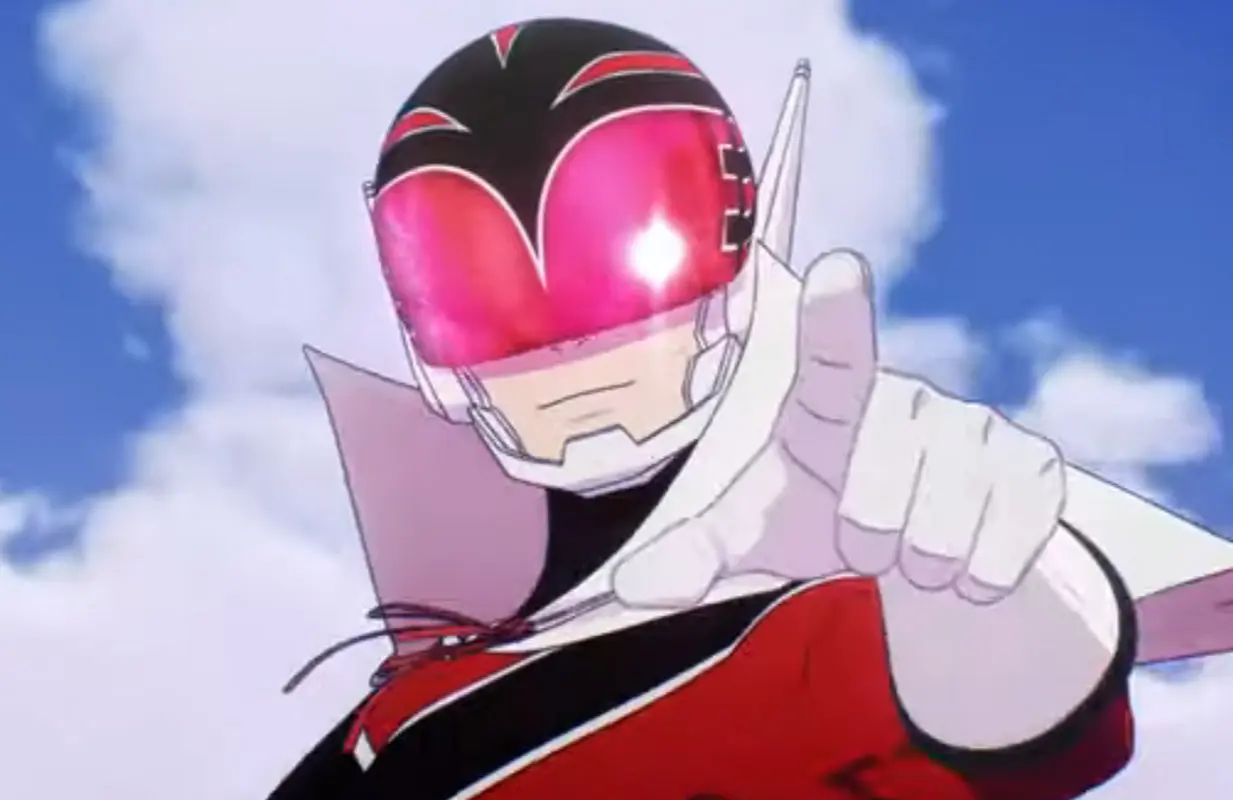Go! Go! Loser Ranger! Gives the Power Rangers a Gritty The Boys Makeover
-
 (Screenshot: Go! Go! Loser Ranger!)
(Screenshot: Go! Go! Loser Ranger!)The Boys debuted at the perfect time — just as the superhero bubble was starting to burst, along came this subversive story that not only delivered an effective "what if superheroes were evil and super violent?" tale, but offered poignant commentary on the very nature of the genre, as well as politics and capitalism. Now, what The Boys did for Marvel and DC heroes, the new anime Go! Go! Loser Ranger! does for tokusatsu, specifically the sentai part of the genre.
Sentai is a subgenre involving teams of almost identical, color-coded superheroes — think Mighty Morphin Power Rangers — who fight monsters and kaiju, often with the help of a combined mecha. Though there are many sentai shows, they have about as established a formula as your standard American superhero comic; even if you haven't seen Power Rangers, you likely know enough from cultural osmosis to get the idea.
Go! Go! Loser Ranger! does more than just subvert the formula, it interrogates the entire genre. In the show, the Villainous Army of Evil arrived 13 years ago on Earth seeking to destroy everything. They were stopped by the Dragon Keepers, a team of color-coded heroes that look like your standard sentai team.
After obliterating the higher-ranked monsters of the Army of Evil, the Dragon Keepers decided to spare the Dusters — essentially Rita Repulsa's Putty Patrollers, or Putties — and instead offer them a deal. Every Sunday, the Dusters are forced to descend from their base and reenact their defeat against the Keepers as part of an elaborate, sold-out show in front of a crowd of enthusiastic spectators. Given their ability to morph their bodies at will, one Duster is tasked with becoming a unique kaiju while the rest serve as cannon fodder until they are brutally killed for the entertainment of the masses in renditions of the kind of live show Mighty Morphin Power Rangers did in the '90s.
Granted, this is not the first deconstruction of sentai in anime; 2022’s Love After World Domination turned the subgenre into a rom-com. What makes Go! Go! Loser Ranger!’s reimagining so powerful is that it positions the Keepers, who would ordinarily be the heroes of this story, as the villains, now sitting atop an industrial complex built on genocide. You see, as the Dragon Keepers grew in popularity, they stopped being a simple team of "heroes" and became a corporate entity. Much like Vought’s The Seven, they have corporate sponsors, merchandise, and even their own paramilitary organization with tiers of soldiers and junior members serving under each of the Keepers, each battalion with distinct responsibilities: the spies, the soldiers, the planners, the ones in charge of covering up incidents.
Unlike The Boys, GGLR does see people vocally disagree with the Keepers and the 13-year-old, still-ongoing "war" they sell the audience. The Sunday Showdown becomes the key to their propaganda machine to trick audiences into thinking they still need the Keepers and their exceedingly large organization. What the public doesn't know, however, is that the villains don't have infinite foot soldiers. It's the same group time and time again. Dusters are immortal, they can only be killed with a special weapon the Keepers constantly threaten them with. So when they are defeated in the arena every week, they spawn back at their floating base in the sky, a clever take on the endless Putties in Power Rangers.
Go! Go! Loser Ranger! is rooted in a horrific premise, with the Keepers essentially enslaving the Dusters to kill them en masse repeatedly in an endless genocide. Much like in The Boys, the protagonist of the anime is someone who has experienced the horror and cruelty of the "heroes" firsthand. We follow Fighter D, a Duster tired of the nightmare of existing not just to lose, but to be killed while kids call for his violent demise. He tries to infiltrate the Keepers, posing as one of their own in order to kill them all.
We've seen many stories about superheroes gone rogue, from Superman: Red Son to Injustice: Gods Among Us and The Boys. But they all still follow traditional heroes or antiheroes. Sure, Butcher border on being a terrorist at times, but from his very first appearance, we’ve thought of him as being one of the "good guys," at least, compared to The Seven. Go! Go! Loser Ranger! urges the viewer to side with a minion among the alien monsters, the nameless foot soldier. Fighter D is the kind of character who ordinarily doesn't even register for the audience, who are usually drawn to either the heroes or the cool, unique kaiju that appear every episode and have much better designs. What makes Go! Go! Loser Ranger! special is that it flips the entire thing on its head, making the audience root for not Joker, not Thanos, but one of those random Chitauri soldiers in the background of The Avengers.
Go! Go! Loser Ranger! Season 1 is streaming on Hulu.Rafael Motamayor is a freelance writer and critic based in Norway.
TOPICS: Go! Go! Loser Ranger!, Hulu, The Boys, Mighty Morphin Power Rangers, Anime, Sentai, Superhero TV